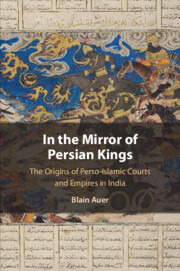Book contents
- In the Mirror of Persian Kings
- In the Mirror of Persian Kings
- Copyright page
- Dedication
- Contents
- Figures and Maps
- Maps
- Preface: In the Mirror of Persian Kings in India
- Abbreviations
- A Note on Transliteration
- 1 The History of Persian Kingship and Persianization in South Asia
- 2 Kings in History
- 3 Warrior King
- 4 Theory and Application of Persianate Political Ethics in India
- 5 The Pen, the Sword, and the Vizier
- Conclusion
- Bibliography
- Index
5 - The Pen, the Sword, and the Vizier
Published online by Cambridge University Press: 17 April 2021
- In the Mirror of Persian Kings
- In the Mirror of Persian Kings
- Copyright page
- Dedication
- Contents
- Figures and Maps
- Maps
- Preface: In the Mirror of Persian Kings in India
- Abbreviations
- A Note on Transliteration
- 1 The History of Persian Kingship and Persianization in South Asia
- 2 Kings in History
- 3 Warrior King
- 4 Theory and Application of Persianate Political Ethics in India
- 5 The Pen, the Sword, and the Vizier
- Conclusion
- Bibliography
- Index
Summary
Working alongside sultans were great numbers of men who were highly skilled in administrative and military matters who aided the ruler in the imperial project. Running an empire demanded trustworthy individuals who could implement the king’s political agenda. This was made possible by the administrative system with all its various offices and distribution of responsibilities. The highest office belonged to the vizier or chief minister whose portfolio included a vast array of duties. But the vizier was not simply one of the “men of the pen” or an intellectual mouthpiece. The office of vizier existed since Abbasid times and saw various changes over the course of Islamic history. This chapter demonstrates how those individuals had a major impact on the history of Islamicate South Asia.
Keywords
- Type
- Chapter
- Information
- In the Mirror of Persian KingsThe Origins of Perso-Islamic Courts and Empires in India, pp. 161 - 187Publisher: Cambridge University PressPrint publication year: 2021

